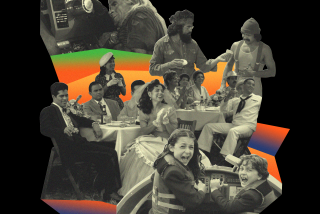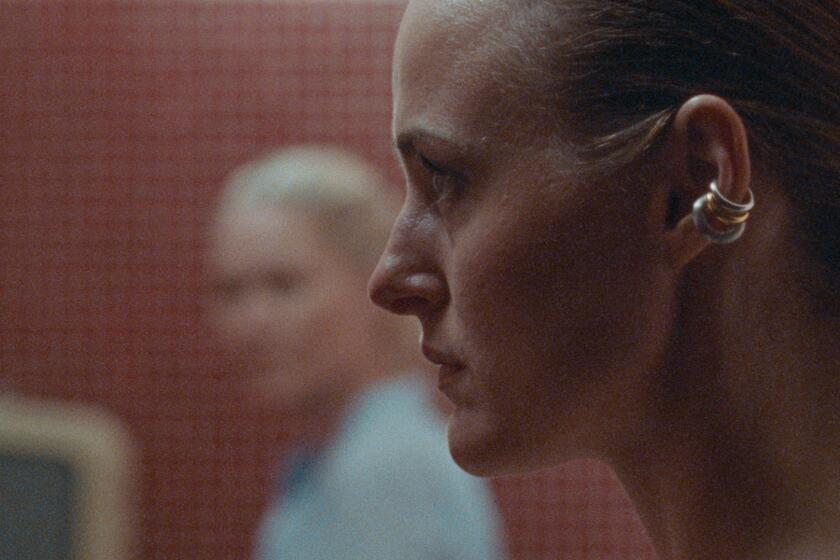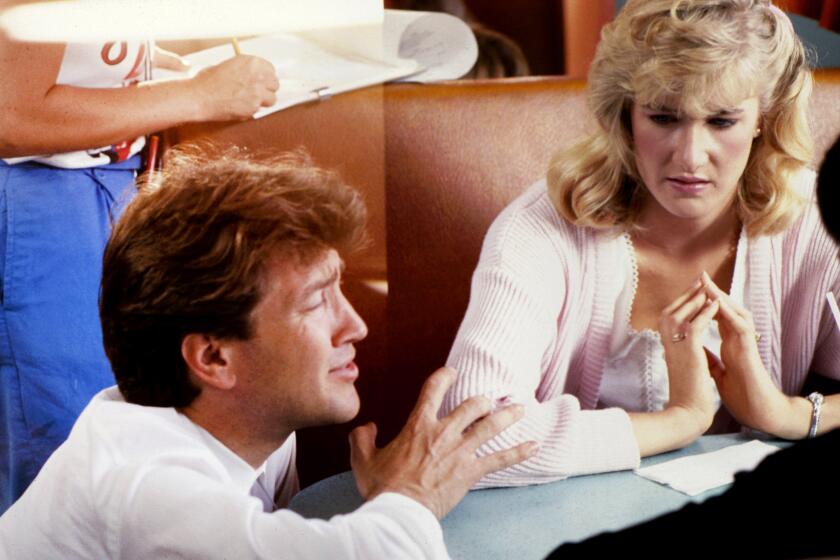AFI’s Top 100 List: The Ultimate Pitch
- Share via
After months of carefully calibrated hoopla, the AFI 100 were liberated before a nationwide TV audience Tuesday night, bringing to mind Oscar Wilde’s famous regret at having put his genius into his life, not his work.
As the real Hollywood art form is famously the deal rather than the movie, so the genius of the American Film Institute’s 100 Greatest American Movies of All Time compendium is almost exclusively in the packaging and marketing, not the contents. And that turns out to be both wasteful and a shame.
Of course, Wilde did put some genius into his work, and the AFI list [see F5] is not without strengths, including a Top 10 that is by and large solid and respectable: “Citizen Kane,” “Casablanca,” “The Godfather,” “Gone With the Wind” [see interview with star Olivia De Havilland below], “Lawrence of Arabia,” “The Wizard of Oz,” “The Graduate,” “On the Waterfront,” “Schindler’s List,” “Singin’ in the Rain.”
It’s fitting that 1939, often thought of as the pinnacle of American filmmaking, has five films in the top 100, adding “Stagecoach,” “Wuthering Heights” and “Mr. Smith Goes to Washington” to “Gone With the Wind” and “The Wizard of Oz.” Katharine Hepburn is the most represented actress, with four films, while the durable Ward Bond, of all people, tops everyone with seven appearances.
And given that today’s youthful audience regards films made before 1980 as coming from the dawn of recorded time, the AFI list will without doubt be valuable in bringing appreciative new audiences to pictures 30, 40, 50 years old and more that still reward viewing today.
Which is why the omissions on the AFI list, and they are numerous, are frankly a scandal. This is not the to-be-expected critical quibbling about this or that obscure favorite not getting its place in the sun, the kind of thing AFI Chairman Tom Pollock was thinking of when he grandly acknowledged early in the process that people “will invariably disagree with some choices.” This, to put it in another context, is like making a list of 100 best American novels and forgetting about Hemingway and Fitzgerald.
Completely absent from the list are any works by three of the greatest of Hollywood’s comedy directors, men whose films were and continue to be enormously popular and influential around the world. Where is the brilliant silent clown Buster Keaton, easily the equal of Charlie Chaplin? Where is Ernst Lubitsch, whose films (“Ninotchka,” “Trouble in Paradise,” “Little Shop Around the Corner” and “To Be or Not to Be” among them) remain models of romantic sophistication? And where is Preston Sturges, whose rapid-fire comedies like “The Lady Eve” and “Sullivan’s Travels” set the standard for verbal humor? Not on the AFI list, that’s where.
Wait, there’s more. Not to be found on the AFI list are any of the transporting dance films with Fred Astaire and Ginger Rogers, not to mention the dazzling choreography of Busby Berkeley. Not to be found are any of the films of Greta Garbo, arguably the greatest film actress of all time, not even her heartbreaking “Camille.” Not to be found is “Gunga Din,” without whose example everything from “Star Wars” to “Raiders of the Lost Ark” might not have happened. No wonder Jean Firstenberg, the AFI’s director, seemed to be backing away from the list in a recent interview, calling it only “a suggested exercise.”
The paradox of the AFI 100 is that these omissions are so critical because the institute, understandably desperate for money after funding cutbacks in Washington, did such a phenomenal job of selling the concept. Each of the sponsors for Tuesday night’s three-hour star-filled CBS special, which included Cadillac, the U.S. Postal Service, Target Stores and Blockbuster Video, paid a reported $2.3 million for their share, and Newsweek, also a sponsor, comes out today with a special issue of the magazine tied to the list.
More than that, the TNT network will be presenting a 10-part series of one-hour specials focusing on the AFI 100 starting June 23. And, in what is being described as an unprecedented display of cooperation, 13 studios and film companies have collaborated on a joint video release of the 100 films, an event Video Store magazine called “the closest thing to a generic ad campaign the rental industry has ever seen.”
The results of this are not hard to see: Any film or filmmaker that didn’t squeeze into the top 100 will be, in effect, consigned to the equivalent of the ninth circle of hell. While Keaton may not be measurably harmed by his exclusion from the canon, the same can’t be said for giants like Lubitsch and Sturges, and that is close to criminal. If the AFI truly took seriously its mission to “focus attention on the need to preserve America’s film heritage,” it would have taken steps to ensure that that didn’t happen.
The problem started with the list of 400 films, prepared in-house by the institute, that the 1,500 voters had to choose from. No one knows what went on behind closed doors in the making of that list, but one factor that seemed to carry weight with the compilers was which filmmakers could be helpful to the institute in the here and now.
So while only one Keaton film (“The General”) made the list of 400, seven by Steven Spielberg were included, as were six by Martin Scorsese, as opposed to four by Sturges and three by Lubitsch. When the British Film Institute picked a recent list of the 360 most significant films worldwide, it put some 60 silents on the list, roughly three times the AFI 400 number.
Because the deck was stacked this way, it’s not surprising that only four silents made the final selection and that Keaton was shut out while Spielberg was the most chosen director with five films on the list. Scorsese, whose grasp of film history is second to none, must be embarrassed to find three of his films on the top 100 with such great names shut out.
No list of the 1,500 voters has been released (for the record, critics including myself were among them), but the AFI’s description of the group as “leaders from across the American film community” is not promising.
Just like you wouldn’t want critics to be making films, as you wouldn’t necessarily want the people who run presses to pick the 100 best American novels, so having a cross-section of actors, directors, writers, agents and executives to pick the 100 best films is chancy at best. Not because their taste is suspect, but because nothing in their job descriptions makes it inevitably or even likely that they’ll have a knowledge of the entire breadth of film history. When you use a group like that as voters, you get the kind of skewering toward the familiar and the obvious that the AFI got; the institute’s list of 100 includes eight films made between 1990 and 1996 and only 13 for the much wider span from 1912 to 1938.
Even if you take the list of 400 and the 1,500 voters as a given, the responsible thing for the AFI to have done, given what a lasting impact this list is likely to have, was to have a kind of oversight committee, similar to the one the Pulitzer Prizes has, to correct any egregious oversights. I’m not talking about critics; even Firstenberg and Pollock would likely have corrected the most obvious flaws if they took their mission seriously and had the chance.
But that would have disturbed the purity of the one-person, one-vote gimmick and might have made the concept harder to sell to all-important sponsors. When the choice came to doing what was right, to being responsible both to history and to the future, or going with the money, the AFI went with the money, and a once-in-a-lifetime opportunity to do this right was squandered. Yes, they need the dollars desperately, but it still doesn’t seem like the best way to go.
(BEGIN TEXT OF INFOBOX / INFOGRAPHIC)
100 Years . . . 100 Movies
This is the American Film Institute’s list of 100 greatest American movies produced during the first 100 years of American filmmaking.
1. “Citizen Kane”: 1941
2. “Casablanca”: 1942
3. “The Godfather”: 1972
4. “Gone With the Wind”: 1939
5. “Lawrence of Arabia”: 1962
6. “The Wizard of Oz”: 1939
7. “The Graduate”: 1967
8. “On the Waterfront”: 1954
9. “Schindler’s List”: 1993
10. “Singin’ in the Rain” : 1952
11. “It’s a Wonderful Life”: 1946
12. “Sunset Blvd.”: 1950
13. “The Bridge on the River Kwai”: 1957
14. “Some Like It Hot”: 1959
15. “Star Wars”: 1977
16. “All About Eve”: 1950
17. “The African Queen”: 1951
18. “Psycho”: 1960
19. “Chinatown”: 1974
20. “One Flew Over the Cuckoo’s Nest”: 1975
21. “The Grapes of Wrath”: 1940
22. “2001: A Space Odyssey”: 1968
23. “The Maltese Falcon”: 1941
24. “Raging Bull”: 1980
25. “E.T. The Extra-Terrestrial”: 1982
26. “Dr. Strangelove”: 1964
27. “Bonnie and Clyde”: 1967
28. “Apocalypse Now”: 1979
29. “Mr. Smith Goes to Washington”: 1939
30. “The Treasure of the Sierra Madre”: 1948
31. “Annie Hall”: 1977
32. “The Godfather Part II”: 1974
33. “High Noon”: 1952
34. “To Kill a Mockingbird”: 1962
35. “It Happened One Night”: 1934
36. “Midnight Cowboy”: 1969
37. “The Best Years of Our Lives”: 1946
38. “Double Indemnity”: 1944
39. “Doctor Zhivago”: 1965
40. “North by Northwest”: 1959
41. “West Side Story”: 1961
42. “Rear Window”: 1954
43. “King Kong”: 1933
44. “The Birth of a Nation”: 1915
45. “A Streetcar Named Desire”: 1951
46. “A Clockwork Orange”: 1971
47. “Taxi Driver”: 1976
48. “Jaws”: 1975
49. “Snow White and the Seven Dwarfs”: 1937
50. “Butch Cassidy and the Sundance Kid”: 1969
51. “The Philadelphia Story”: 1940
52. “From Here to Eternity”: 1953
53. “Amadeus”: 1984
54. “All Quiet on the Western Front”: 1930
55. “The Sound of Music”: 1965
56. “MASH”: 1970
57. “The Third Man”: 1949
58. “Fantasia”: 1940
59. “Rebel Without a Cause”: 1955
60. “Raiders of the Lost Ark”: 1981
61. “Vertigo”: 1958
62. “Tootsie”: 1982
63. “Stagecoach”: 1939
64. “Close Encounters of the Third Kind”: 1977
65. “The Silence of the Lambs”: 1991
66. “Network”: 1976
67. “The Manchurian Candidate”: 1962
68. “An American in Paris”: 1951
69. “Shane”: 1953
70. “The French Connection”: 1971
71. “Forrest Gump”: 1994
72. “Ben-Hur”: 1959
73. “Wuthering Heights”: 1939
74. “The Gold Rush”: 1925
75. “Dances With Wolves”: 1990
76. “City Lights”: 1931
77. “American Graffiti”: 1973
78. “Rocky”: 1976
79. “The Deer Hunter”: 1978
80. “The Wild Bunch”: 1969
81. “Modern Times”: 1936
82. “Giant”: 1956
83. “Platoon”: 1986
84. “Fargo”: 1996
85. “Duck Soup”: 1933
86. “Mutiny on the Bounty”: 1935
87. “Frankenstein”: 1931
88. “Easy Rider”: 1969
89. “Patton”: 1970
90. “The Jazz Singer”: 1927
91. “My Fair Lady”: 1964
92. “A Place in the Sun”: 1951
93. “The Apartment”: 1960
94. “GoodFellas”: 1990
95. “Pulp Fiction”: 1994
96. “The Searchers”: 1956
97. “Bringing Up Baby”: 1938
98. “Unforgiven”: 1992
99. “Guess Who’s Coming to Dinner”: 1967
100. “Yankee Doodle Dandy”: 1942
More to Read
Only good movies
Get the Indie Focus newsletter, Mark Olsen's weekly guide to the world of cinema.
You may occasionally receive promotional content from the Los Angeles Times.











